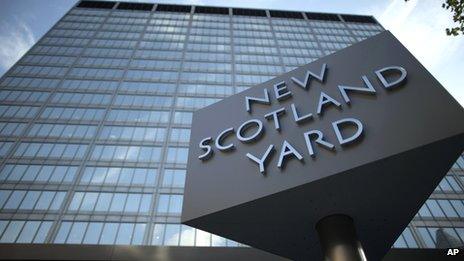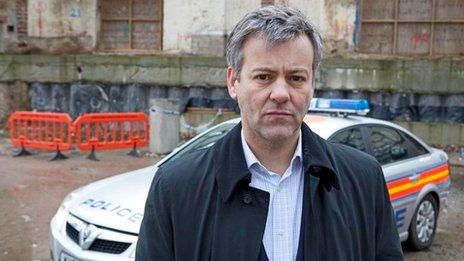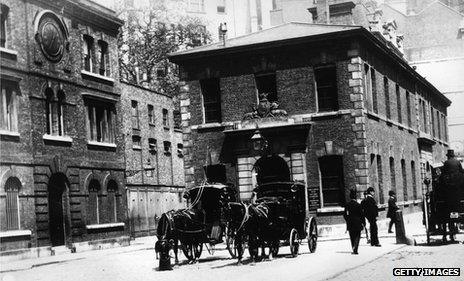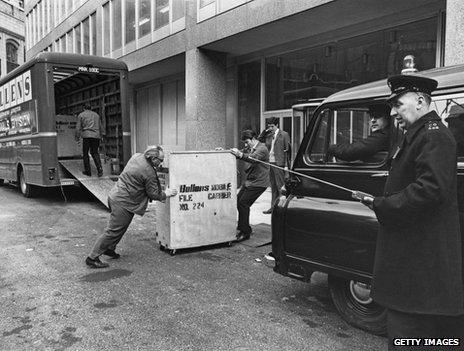The fictional view of Scotland Yard
- Published

London's Metropolitan Police is planning to sell off its headquarters, New Scotland Yard. It's a name that is embedded in popular fiction, writes crime novelist Andrew Taylor.
Around the world, the words Scotland Yard mean something. Like Wall Street and Westminster, the name summons up a host of associations. It exists in fiction, on the page and on the screen, as much as in fact.
Scotland Yard is the name of the headquarters of London's Metropolitan Police, founded in 1829, one of the oldest modern police forces in the world and arguably the best known. The name comes from the location of the original HQ, with a public entrance in a street called Great Scotland Yard.
Within a few decades the name Scotland Yard was almost synonymous with the police force itself. The name migrated with the force to its new and much larger headquarters, New Scotland Yard, first on the Victoria Embankment and, in 1967, in Victoria.
In the mind of the public, however, Scotland Yard became associated with a special sort of police officer - the detective, the professional expert called to investigate crime, especially murder, the greatest crime of all. The Metropolitan Police set up a detective force as early as 1842. London needed it badly - the Victorian city was a hotbed of crime and vice.
Almost immediately, Scotland Yard's detective branch caught the public's imagination. The work of real-life officers such as Inspector Whicher was publicised by contemporary writers. Soon police detectives were appearing in fiction, among them Inspector Bucket in Dickens' Bleak House (1853) and the rose-growing Sergeant Cuff in Wilkie Collins' The Moonstone (1868).
The activities of Inspector Whicher and his colleagues weren't confined to London. Other police forces around the country increasingly summoned detectives from "the Yard" to deal with crimes that baffled their own less experienced officers. Once again, fiction followed fact.
At first, fictional detectives of the Yard were portrayed as almost superhuman figures, drawing on mysterious powers and capable of solving the most complicated cases. But something happened to change this in 1887.
Sir Arthur Conan Doyle published A Study In Scarlet, the first of his Sherlock Holmes stories. One result was that the Yard's reputation in popular culture was no longer quite so flattering.
The Scotland Yard officers in Sherlock Holmes stories are almost always shown as well-meaning but unimaginative - and even rather stupid. They have to be, because otherwise Sherlock Holmes would be out of a job.

Rupert Graves as Inspector Lestrade in the BBC's latest incarnation of Sherlock
As a result, the unfortunate Inspector Lestrade is probably fiction's best-known Scotland Yard detective.
Lestrade has nothing to recommend him but his tenacity. He even looks unappealing - Conan Doyle variously describes him as "a little sallow rat-faced, dark-eyed fellow" and "a lean, ferret-like man, furtive and sly-looking". He appears in 13 of the stories and regularly features in film, TV and radio adaptations. In a sense, Holmes needs Lestrade as much as Lestrade needs Holmes.
By this time, the public had realised that in real-life Scotland Yard wasn't quite as clever as they had thought - a point rammed home when the still-unsolved Jack the Ripper murders started in 1888.
So, in fictional terms at least, glamorous amateur and private investigators seemed much more attractive than the clearly flawed Scotland Yard detectives of real life.

The original Scotland Yard, pictured left
Scotland Yard's popular reputation also had a tough time after World War I in both novels and films.
In Britain, fiction's detectives tended to be upper-class amateurs like Dorothy L Sayers' Lord Peter Wimsey or superior private investigators such as Agatha Christie's Hercule Poirot.
Lord Peter bosses about the Scotland Yard detectives he encounters (even Inspector Parker, who becomes his brother-in-law), while Poirot patronises the slightly comical Inspector Japp. In the TV series, Agatha Christie's Poirot, Japp's role (wonderfully played by Philip Jackson) is much more significant than in the original books and becomes a foil to David Suchet's Poirot.

The Met then moved to New Scotland Yard...
After World War II, however, Scotland Yard and its detectives tended to be portrayed a little more realistically.
In a less snobbish era, the professionalism of Scotland Yard has earned more respect. Gideon of the Yard, for example, created by the prolific John Creasey, was a long-running series that made the transition to both film and television.
The BBC's Fabian of the Yard (1954-56) was a series based on the career of the real-life Detective Inspector Robert Fabian, focusing on forensic science. PD James's series hero, Commander Adam Dalgliesh, is another positively portrayed fictional Scotland Yard detective who made the move from page to screen.

... and then into an even newer New Scotland Yard in 1967
Not that Scotland Yard hasn't attracted its share of mockery too - an abiding image for many people remains the Not the Nine O'Clock News sketch in which the commissioner is shown hard at work, laboriously turning the iconic rotating sign of the headquarters building.
Will Scotland Yard still mean something in popular culture if its headquarters is sold?
Of course it will. The Metropolitan Police will find a new home and take its old name with it, just as it did before.
Scotland Yard is more than a place. The name will endure as long as London needs police detectives, whether in fact or fiction.